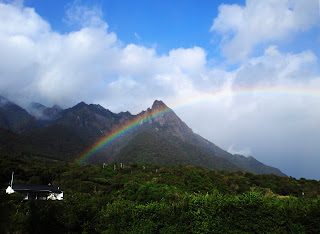Of all of Yakushima's Exterior Mountains, this is one of the most popular peaks. It's an intense uphill climb, and, tragically, weary hikers have gotten lost, but the rewards are plentiful.
屋久島の前岳の一つ、モッチョム岳は最近、遭難事故があったが、モッチョム岳はかなり魅力的な山で、とっても人気です。この激しい登山を挑戦すれば、「洋上のアルプス」に一目惚れするでしょう。
 |
| Senpiro Falls |
登山口は屋久島の天気のいい(まぁ、北部に比べて、、)南部にある千尋の滝の展望台の近くに位置しています。とっても美しい滝です。普段は水量は少ないですが、屋久島の特徴である険しい花崗岩の斜面と川の危険がとてもわかりやすいです。上流で人が亡くなった例もあります。
If you've done a lot of hiking in Japan before, than you may be used to this sort of medium-maintenance trail. As with most hikes off the beaten path, you won't find any wooden staircases. Instead you'll be searching for trail markers (pink tape) as you go an navigating rocks, roots, and a couple streams. The terrain can be slippery and foggy. Get an early start so that nightfall doesn't catch you on this trail.
日本でハイキングの経験を富んでいる方は、こういうまま整備されている山道に慣れているかもしれませんが、屋久島のマイナーなルートとして、木製階段は一つでもありません。その代わりにピンクテープを探しながら、石、根っこ、沢渡みたいな障害物が多いです。雨の後、滑りやすくなって、霧も多いです。朝一でスタートして、暗くなる前に下山を終了しましょう。
 |
| Bandai Sugi |
 |
| Taro |
一つ目も二つ目の沢の間は、かなり険しいクライムですが、その日本の屋久杉が待っています。それは、万代杉とモッチョム太郎と呼ばれています。麓の集落の幼稚園の子供たちは、毎年万代杉まで登っていますよ。あんまり疲れたら、根っこに傷をつけないように気をつけながら、万代杉で休憩しましょう。笑
 |
| Coptis Ramosa |
コケに覆われた谷に付き、おいしい水はありますし、どんどん登ると、植物の垂直分布はきれいに見えます。標高が高くなると、冬か春ならオウレン 、夏ならシャクナゲが咲いて、色とりどりの虫が飛びます。秋なら、標高の低い所で、寄生植物が見つけられるかもしれません。駐車場にも面白い植物がありますよ。それは、虫を食べるコモウセンゴケです。(本当の苔ではありません。)運が良ければ、ランの仲間、水晶、猿との出会いも可能ですが、この山道は世界遺産に含まれていますので、充分ご注意下さい。
 |
| Alas, the peak! |
モッチョム岳を挑戦するのには、ある程度体力が必要です。根っこや岩が多く、手足を使いながら登ります。最後にロープを使って登るところ2ヶ所ぐらいあります。夏でも、軽いジャケットと、そうして弁当とお水を持参して下さい。携帯は会社によって、だいたい繋がりますが、基本の救急箱や笛の持参も進めます。
 |
| Shrine at the peak |
The beauty of this mountain goes beyond its physical description. There's a certain peace to be had after visiting the small shrine and sitting on the rocks at the peak, looking out over southeastern Yakushima.
この山の独特の魅力は説明しにくいものです。祠を見つけ、山頂の岩の上に座りながら、屋久島の南東の山々や集落を見渡して、深い空間を楽しめます。
Peak Elevation: 940m
Trail Head Elevation: ~350m
Map time: 6+ hours round trip for people in top shape. 8+ hours is typical.
Bus stop: It's a long walk from the main road, but that doesn't stop people.


Very useful report on the hike, Jenny.
ReplyDeleteWhat is the situation of the trail in late October, and of the leeches on the trail at that time? Is salt still the best way to get rid of attached leeches, or is a lighter better?
Has trail maintenance made the trail easy to find/follow, or has overgrowth gotten the better of the trail>
Hi Jenny, your post and blog are very helpful.
ReplyDeleteI was wondering what the condition of the hike/terrain and leeches is in late October. Also what is the best way to deal with leeches? Is it still salt, or is a lighter better? Lastly, has trail maintenance allowed the trail to be found and followed easily, or does overgrowth make it difficult to follow?
Hi Nasci!
ReplyDeleteSorry I haven’t checked comments in a long time! I personally think the best (clean, fast, easy, and less cruel) thing to do is run your fingernail under its mouth to break the suction, and then just pluck it off. Last year Mocchomu had a lot of leeches, and it looks like it will this year, too, from June through to December or whenever it gets cold...
I personally think this trail is easy to follow except when it’s dark and/or foggy. There’s an area just below Bandai Sugi that I don’t think I could navigate in bad conditions if I didn’t know the trail. Fortunately, there is cell service mist of the way!